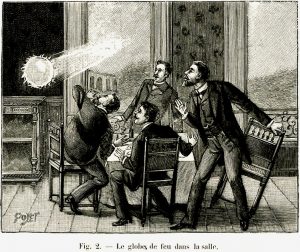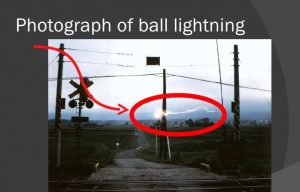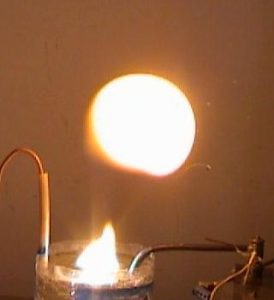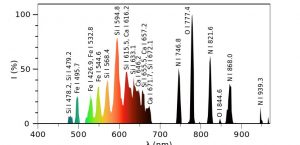Descriptions of the strange, almost unearthly phenomenon known today as Ball Lightning date back as far as Aristotle. However the recorded incidents of ball lightning have been so infrequent, and the behavior of the phenomenon so varied, even contradictory that up until the mid-twentieth century many if not most scientists regarded ball lightning to be an imaginary rather than a real physical event. The image below shows an illustration of a nineteenth century occurrence of ball lightning.

It is true that ball lightning can range in size from less than a centimeter to as much as a meter in diameter. The colour of ball lightning can also vary tremendously although red, orange and yellow predominate. The movement of ball lightning is generally horizontal but they have been known to move up or down or even remain motionless. They can even appear right out of walls or other solid objects.
Perhaps the greatest variance in the different observations of ball lightning however is in the way they dissipate. Sometimes they can just disappear like a light bulb that’s turned off while sometimes they disappear by passing into walls or other solid objects. And then sometimes they can explode doing considerable damage and even death. The image below shows of modern photograph of ball lightning.

About the only things that all the different reported incidents agree upon is that ball lightning usually occurs during a thunderstorm and normally right after ordinary cloud to ground lightning bolt has struck nearby. Over the last century however reports of ball lightning have also been connected with heavy electrical equipment like generators and there are even reports of ball lightning occurring in submarines during World War II went the sub was switching from its diesel engines to battery power.
Theories about the nature of ball lightning abound and over the last 50 years scientists have even succeeded in produced ball lightning-like objects in the labouratory. Despite these successes there are arguments as to whether those labouratory creations are the ‘real’ ball lightning. The image below shows one of the labouratory attempts to create ball lightning.

The best data concerning natural ball lightning comes from a group of scientists from Northwest Normal University in Lanzhou China who in July of 2012 were studying ordinary cloud to ground lightning on the Tibetan plateau. While they were making their observations they spotting ball lightning and were able to record 1.6 seconds of video of the event. Because the cameras that the scientists were using in their cloud to ground lightning observations were equipped with slitless spectrographs the researchers also succeeded in obtaining the first ever optical spectra of ball lightning.
The spectra obtained by the scientists showed strong emission lines for the elements of silicon, calcium, iron, nitrogen and oxygen. The spectra also showed that the ball lightning had a temperature of less than 14,000K. See spectra below.

This remarkable data has bolstered one of the leading theories about the origin of ball lightning, the ‘Vapourized Silicon Hypothesis’. In this model ordinary lightning strikes the ground vapourizing and ionizing the silicon-dioxide in the soil. As the vapour cools the silicon becomes an aerosol that is bound together by the charges on the ions. The glow of the ball lightning is produced as the silicon recombines with the oxygen.
There are rival hypotheses however, some rooted in solid science, some a little bit kooky. The Microwave Cavity Hypothesis considers ball lightning to be generated by microwave radiation that ionizes the air with the discharge of that ionization causing the glow. The problem with this idea is that while ordinary cloud to ground lightning does produce a lot of radio energy most of it is in the AM and short wave bands rather than microwaves.
Then there’s the Electrically Charged Solid Core hypothesis where a solid object acquires a positive electric charge and becomes surrounded by a layer of electrons. A microwave field keeps the positive and negative charges apart and the high voltage generated between the charges is what we see as the ball lightning. In addition to requiring microwaves again this hypothesis also requires a solid object inside the ball lightning, something not seen in any observations, as well as being something that would have difficulty in passing through solid walls!
Among the more outlandish suggestions there is the mini-black hole model where an atom sized, primordial black hole is passing through our atmosphere and we see it as ball lightning. However there is no reason for a mini-black hole to be as closely associated with ordinary lightning or large electric generators as ball lightning certainly is. Also a mini-black hole would not simply blink out of existence as ball lightning is known to often do.
The mystery of ball lightning will probably continue for some time into the future. However, with so many people nowadays carrying cell phone cameras with them we are likely to get more and better observations of the phenomenon. At the same time scientists will continue working in their labouratories to discover more ways of creating ball lightning-like objects. Considering only 50 years ago some scientists even doubted the existence of ball lightning we’ve made a lot of progress. Clink on the link below to be taken to a youtube video of ball lightning taken outside New Orleans in 2015.
https://www.youtube.com/watch?v=U9SrGOma5YE
